The nice thing about a small island is that pretty much anywhere on the island constitutes a day trip from anywhere else. At most it will take you an hour and half to get from one side of the island to the other, and in most cases a lot less.
There are some amazing places to visit around the island, but we are using our starting point as Palma as it is well connected with the rest of the island and there is no need to hire a car, but if you choose to hire a car, the roads are nice and easy.
1. Soller by Train
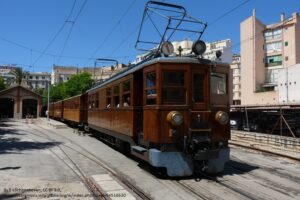 Step back in time on this unique railway. Departing from Palma, this old wooden train makes the 17 miles journey to Soller every day and has done since 1911. Get there early to watch the manoeuvres of the coupling of the engine to the rest of the train, with trumpet blasts of the guards and the serious beeps of the ancient machinery. It is a picturesque trip once out of the suburbs of Palma.
Step back in time on this unique railway. Departing from Palma, this old wooden train makes the 17 miles journey to Soller every day and has done since 1911. Get there early to watch the manoeuvres of the coupling of the engine to the rest of the train, with trumpet blasts of the guards and the serious beeps of the ancient machinery. It is a picturesque trip once out of the suburbs of Palma.
Soller itself became wealthy due to the valley’s citrus groves. In 19th century, the area was very isolated from the rest of Mallorca. The fruit was shipped to France from the port. Several locals went to work in France but returned once they had made their fortune. They built handsome Modernista properties that grace the town today and gives Soller a truly individual feel.
Take the tram from the train station down to the Port for another unforgettable experience while you are there.
2. Day trip to Deia
The small coastal village of Deià, on the northwest coast and is probably the prettiest villages on the island. Situated at the foot of the Teix mountain in a ravine, giving amazing views across the Mediterranean.
 Deià has long been a magnet for famous artists, musicians, writers and well known individuals. A friend was eating at a local restaurant on his birthday, a cake appeared and the person on the next table started singing ‘happy birthday’, that person being Andrew Lloyd-Webber. We can’t promise you a celebrity on your visit but keep your eyes open.
Deià has long been a magnet for famous artists, musicians, writers and well known individuals. A friend was eating at a local restaurant on his birthday, a cake appeared and the person on the next table started singing ‘happy birthday’, that person being Andrew Lloyd-Webber. We can’t promise you a celebrity on your visit but keep your eyes open.
Deià is part of a landscape awarded World Heritage Site status for the way in which nature, culture and traditions merge seamlessly.
3. Valldemossa
The town of Valldemossa is just over 10 miles from Palma and is located in the Tramuntana mountains. The highest town in Mallorca and surrounded by the terraced terrain. Originally named after the area’s a Moorish landowner called Muza. The Polish composer Chopin and his lover, the famous writer George Sand, spent the winter of 1838/9, renting rooms in the Royal Carthusian (Real Cartuja) Monastery. You can still visit the monastery monastery including the church, cloisters, the old pharmacy, and the cells where it is believed that Chopin and Sand stayed, and it still contains the composer’s piano and other artefacts.
Part of the monastery once was King Sancho’s palace which was gifted to monks, who converted it and other buildings into the monastery. The monastery possibly is probably the second most visited site on the Island, Palma Cathedral being the number one spot.
In August, there is an annual Chopin Festival, the orchestras comprising of a variety of international musicians.
4. Drach Caves
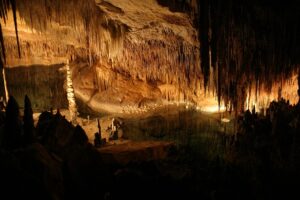 The name Drach comes from the word ‘dragon’, the protagonist of one of the most magical stories of the Balearic Islands. According to the legend there is still hidden treasure within the caves and in ancient times, pirates and buccaneers explored the dark passages of the caves in search of it.
The name Drach comes from the word ‘dragon’, the protagonist of one of the most magical stories of the Balearic Islands. According to the legend there is still hidden treasure within the caves and in ancient times, pirates and buccaneers explored the dark passages of the caves in search of it.
Located on the east coast of Mallorca in the town of Porto Cristo, these caves are simply stunning. The caves are around 1,200 metres in length with a maximum depth of 25 metres below ground level. In the caves is a large underground lake, Lake Martel, which is regarded as one of the biggest underground lakes in the world.
There are four interconnecting caves, the Black Cave, White Cave, Cave of Luis Salvador and Cave of the French. It is believed that the caves were formed when the Mediterranean Sea forced water through the entrance.
5. Formentor
Lying on the northern tip of Mallorca, where the Serra de Tramuntana meets the Mediterranean, you will find Cap Formentor at the end of over a 12 mile peninsula. The sunset particularly in the summer months draws large crowds from people around the world.
By road the scenery is truly spectacular, particularly from Mirador de Mal Pas and Talaia d’Albercutx watchtowers. The lighthouse itself is not open to visitors, but the panoramic views are simply stunning in this unspoilt, wild and rugged spot. From this spot, you can see the pine-lined (known as Pine Walk) the spectacular long white sandy beach with views of the bay of Pollensa, and the crystal clear waters of the Mediterranean.
6. Portocolom
Situated on the east coast lies the village of Porto Colom in the district of Felanitx. Portocolom, named after Christopher Columbus is one of the most attractive on this coast of Mallorca. Portocolom remains a charming traditional fishing village and nestles around a large bay. The lighthouse boathouses and boats are very picturesque and serene. There is a long quay where with local fishing boats and yachts, and you can take boat trips along the coast.
Restaurants and cafés line the quayside, offering everything from traditional Mallorcan to fine dining and as you would expect the seafood is very fresh. On the opposite side of the harbour, there is a church, which is surrounded by pastel-painted fisherman cottages.
7. Alcudia Old Town
A mediaeval town situated on the north of the island the old town of Alcudia boasts a fantastic walled town containing old cobbled streets and with archaeological ruins relating to the many different civilisations that made their home there.
Alcudia Port also boasts a wonderful beach and is a great place for those who love to spend their time in the sea or the surrounding countryside.
The combination of history and proximity to the sea means that visitors to Alcudia can enjoy the best of both worlds.
8. Santuari de Lluc
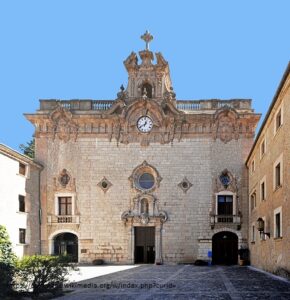 This religious and spiritual site is the most important holy site in Mallorca and even if you are not religious you will soon understand why. Its location at an altitude of 525m means its peaceful surroundings of the valley make it a breathtaking place that could easily inspire prayer, relaxation and tranquillity, even in the non-religious.
This religious and spiritual site is the most important holy site in Mallorca and even if you are not religious you will soon understand why. Its location at an altitude of 525m means its peaceful surroundings of the valley make it a breathtaking place that could easily inspire prayer, relaxation and tranquillity, even in the non-religious.
Every year thousands of locals as well as tourists flock to the pilgrimage site of Lluc to worship the statue of the Black Madonna in the 17th basilica. It is also popular with hikers who can enjoy the restaurant with stunning views as a great place to take a break from one of the many hiking routes in the surrounding area.
9. Platja d’es Trenc
This long white sandy beach to the east of Palma is considered to be one of the best on the island, but you won’t find hotels or cafes here. This beach is in a protected area, so you will find it exactly as nature intended.
Bring a picnic – no cafes to be found – plenty to drink and a good book and enjoy the day away from the more crowded resorts. The sea is a wonderful turquoise blue and is great for snorkelling.
10. Sierra de la Tramuntana
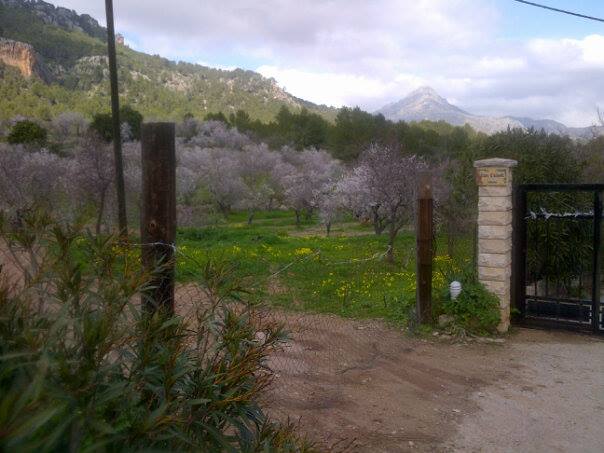
Stunning scenery and beautiful walks in the interior of the island is not what most people think of when considering a holiday in Mallorca, but this mountain range is a wonderful place for hiking. In the spring you will come across fields full of almond blossom and the soft ringing of bells as the lambs and goats roam the mountainside.
With small villages dotted all along the routes, you around bound to find some wonderful places to stop and refuel. Puigpunyent and Calvia are small towns definitely worth putting on your itinerary.
Related articles
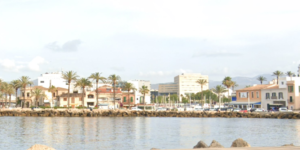
Palma de Mallorca off the beaten track
Palma de Mallorca is renowned for its stunning beaches, vibrant nightlife, and historic landmarks like the majestic La Seu Cathedral.

Top 10 things to see and do in Palma
Mallorca features in almost every tourist brochure that covers Spain and in some people’s minds, it is full of lager
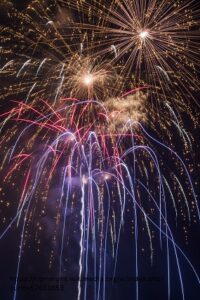
A guide to fiestas in Palma and Mallorca
The island’s fiestas are a testament to its rich heritage, blending historical, religious, and folklore elements into celebrations that captivate
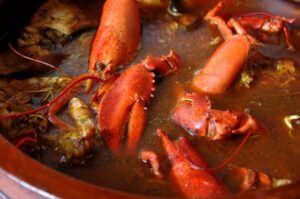
A culinary exploration of Mallorca
Mallorca’s cuisine is a vibrant tapestry woven from Mediterranean influences and local traditions, promising an unforgettable gastronomic journey for tourists

